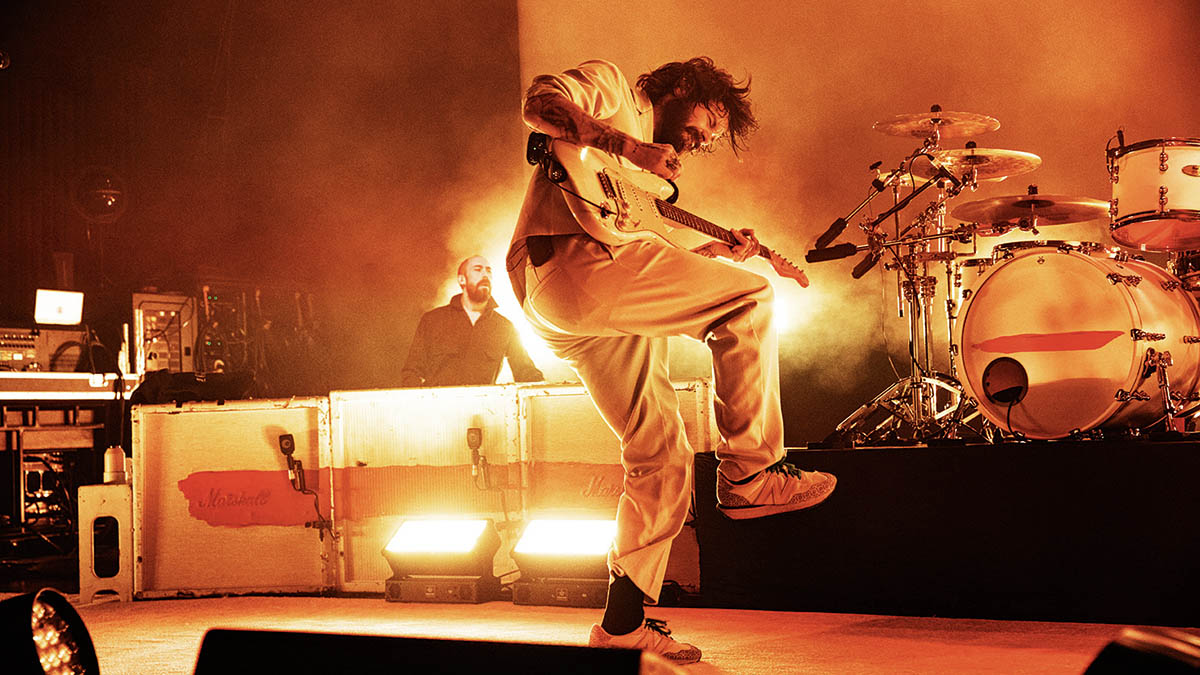Biffy Clyro's Simon Neil: “I swear to God I cannot get rid of the Boss Metal Zone. It’s the one thing that brings the Stratocaster into that real heavy world”
The Biffy frontman shares his fat Strat strategies, demystifies weird time signatures and tells us why the Scottish rockers’ latest album is all joy and togetherness

Dropping a surprise album is the kind of thing you expect more from Taylor Swift than hard-working Scottish rock trios, but that’s what happened when Biffy Clyro’s The Myth Of The Happily Ever After arrived at the end of October 2021.
As guitarist/vocalist Simon Neil says, “There’s part of you feels like it’s total baller – ‘Hey man here’s our new album!’ Like Beyoncé or something. But it’s also extremely terrifying.”
He needn’t have worried, as Biffy fans made it the band’s sixth consecutive Top 5 album. The Myth... has big hooks and huge sonics that belie its rapid creation. And in contrast to the band’s embrace of pop that peaked with 2016’s Ellipsis, this album also features complex riffs in odd time signatures. “Moving back to stranger, more esoteric ideas”, as Simon describes it.
Making music in times of crisis made the band consider their relevance.
“When you’re seeing people going through proper heartbreak every day, you start to wonder ‘Am I contributing to the world? Is this something that needs to exist?’” Simon reflects. But, he concluded, “It’s about trying to bring a sense of joy and togetherness to me and my friends. Just to find that focus and joy was remarkable at this stage of being in a band.”
As well as finding joy in creating music, Biffy Clyro made a life-affirming return to the stage last summer with enormo-shows including headline slots at the Reading and Leeds festivals. They also completed the aptly named ‘Fingers Crossed’ tour at the end of the year.
After this hectic period, Simon is in upbeat mood as he talks about the album, the tour and his new signature pedal, and explains his singular approach to playing, performing, songwriting and gear...
All the latest guitar news, interviews, lessons, reviews, deals and more, direct to your inbox!
Let’s start with The Myth Of The Happily Ever After. What was different about the process of making this album?
“Normally when I’m writing there’s 18 months of working on the songs. This one felt so spontaneous. I didn’t anticipate writing a bunch of songs but it ended up being the way I was processing. Every week all our realities were changing so I was able to focus my energy and my anxieties into the songs.
I’ve always tried to clear the decks before we start a new album. If an idea isn’t good enough the first time round, why is it good enough six years later?
“It was going in to make an album without necessarily knowing how the songs should sound, and that was strange. We did no pre-production. We would normally record ourselves in the practice room. This was like, ‘Here’s a song, let’s record it.’
“The growth period to the record was probably about six to eight weeks and then recording it was about eight weeks, and then suddenly it was done. Normally it takes us that long to rehearse. Because of the pandemic, the purpose of the music felt more pure, knowing that we weren’t going to go out on a promotional tour.”
Was all of the material brand new?
“That’s how I like to work. I like to feel like I’m about to make either the best record we’ve ever made or the worst. When you’ve had an idea that’s floating around, your relationship with that idea can colour any new themes or songs, so I’ve always tried to clear the decks before we start a new album. If an idea isn’t good enough the first time round, why is it good enough six years later?
“I like to have no starting blocks so that I feel the fear. I want to feel like I have to make music. If it’s just a case of ‘time for another album, we’ve got half a dozen ideas, let’s work on them until they’re good enough,’ why bother? At this moment in time I have not one song idea for the next Biffy record!”

What gear did you use?
“I used my Michael Landau signature Stratocaster. I’ve got a couple of them and they are honestly the best-sounding Stratocasters I’ve ever found, so that was the guitar I used for pretty much every song. In terms of amplifiers, I used a Friedman for the very first time and a Matchless.
“We didn’t really have access to all our normal gear so we were trying a few different things. The Friedman BE-100 was an absolute beast. I’m definitely thinking of investing in one.
We weren’t relying on the gear too much. But yeah, there were pedals upon pedals upon pedals
“I used an Audio Kitchen Flying Squirrel which is just a stunning distortion. You can use it as a head or a pedal. I actually use it as a head. I used some EarthQuaker pedals, and the Booooom/Blast pedal. It was about trying to keep things as simple as possible. Normally when we make a record, I feel fortunate to have access to anything. If I want a 1960s Fender amp, I could do it.
“The restrictions of the gear we had this time really helped push the creativity because we weren’t relying on the gear too much. But yeah, there were pedals upon pedals upon pedals. I use the [Jackson Audio] Prism overdrive pedal for on absolutely everything. That just gives the guitar this slight bite and overdrive that that normal clean sound doesn’t have.”
What about speaker cabs?
“I was using the [Universal Audio] Ox Box as a speaker simulator. We were [recording] on a working farm so I couldn’t turn the amplifier up as loud as I wanted. I would have loved to have half a dozen amplifiers just cranked to fuck, but we would have curdled the milk! With this box, I’m able to get the head absolutely cranked that golden zone without needing a speaker.
“The reason I wanted to use the Matchless and the Friedman is they’re so crisp, they’re so factual their sounds. Especially with the Stratocaster, you can really get shimmer.
“Sometimes a clean guitar sound can be the most aggressive tone, so it was trying to get that aggressive sound and then not making the pedals do too much work – just letting the pedals tip it over the edge. That’s just always been the way I’ve worked. I feel like an amplifier is its own thing, but you need to put it through a pedal to really get it to the next level.”
Were you running the Friedman and the Matchless at the same time?
“Just using one head at a time. I learned that from working with Rich Costey [producer of Ellipsis and 2020’s A Celebration of Endings]. When I worked with Garth Richardson, we would use a Soldano head, a Mesa head, and a Marshall all running through different speakers to create the one guitar sound.
“On A Celebration of Endings, we managed to get most of my guitar tones just with an amp. If you can make that one tone sound monumental, there’s a clarity and power you cannot achieve having lots of amps running at once. So, if I did a main track with with the Friedman, I would then shift to another head and do a different part, so never really doubling with different amps.”
If I hadn’t discovered a Strat going into a Metal Zone when I was young I probably wouldn’t have believed you could get that heft to a Stratocaster
How do you make a stock Stratocaster sound so heavy?
“I guess I’m not I’m not scared of the percussive nature of a Strat or the fact it lacks a bit of bottom end. In our band, James [Johnston] takes care of that bottom end with his bass. If I hadn’t discovered a Strat going into a Metal Zone when I was young I probably wouldn’t have believed you could get that heft to a Stratocaster.
“That’s why it’s taken me this long to find that sound with a Strat and one amp. The way I made it work through the years was a combination of a Peavey, old-school Marshall, and a Fender DeVille. One was driven by the Metal Zone, one just being overdriven itself, and the DeVille sat right on top of it all. It took years of experimentation.”

“Sometimes when I hear someone else’s Stratocaster I’m like, ‘Fucking hell, try to get a bit of bottom end out of that!’, forgetting that actually it’s a tricky thing to do. It’s also the way I play. I have a very heavy right hand. I play with heavier strings as well, Ernie Ball Skinny Top Heavy Bottoms [10-52].
“That was a big step in trying to get the muscles on the Stratocaster to show. Every time I rejig my live setup, I try and get rid of the Boss Metal Zone. I swear to God I cannot get rid of it. It’s the one thing that brings the Stratocaster into that real heavy world. Every time I do a blind test, if the Metal Zone isn’t there I hate it. The Metal Zone can give you a real warm and fuzzy bottom end and then everything else just sings and sizzles over the top of it.”
The key to writing weird or progressive or mathy music is that you shouldn’t feel like you’re making it weird
You write in odd time signatures like 5/4 and 7/8. How do you approach that?
“The key to writing weird or progressive or mathy music is that you shouldn’t feel like you’re making it weird. It’s important that it feels physically right. Whenever I write something weird, I stand up and play. Even with weird time signatures you should be able to move and lurch in ways that make sense.
“Sometimes if I get back to the open string on a strange part of the riff I would then loop that part of the riff. Say you’re coming back to the open string on the fifth or sixth note of that riff and start repeating, it’s going to be weird but it’s still in a regular tempo.
“That’s a simple way: just remove one note from your riff and see how it feels. Add an extra note to your riff and see how it feels. These are the ways you discover things that make sense to you musically but also are satisfying to listen to.”
What is your warm-up routine?
“A lot of my warming up involves playing Biffy songs. On a gig day, I’ll normally play guitar for about an hour before the show. I actually feel my most confident when I have my guitar strapped on. The thought of playing guitar on a stage can intimidate me, but as soon as I put the guitar over my chest I’m like, ‘Right, this is me!’
“I learned the hard way about going on cold. Hand cramping is the worst fucking thing. You feel like a lobster trying to play guitar!
“The fear can sometimes make your body tense, and it can really play on your mind. Constantly picking up your guitar takes away that stress. The shows really feel perfect for me when I feel my guitar is just an extension of who I am and I’m not even thinking about what I’m doing.”
How did you prepare for Biffy’s massive comeback shows last summer?
“It was tough! An aspect of it was just hoping that muscle memory would kick in, hoping that things would make sense once we stepped on the stage. The big step for us was just even getting in a room and playing live together. That was the first time where things made sense.
“It was probably only two weeks before we did the shows that we thought, ‘We can do this!’ There’s a level of fear that builds just having not engaged with more than three people for the last 18 months. We were very rusty, my voice was really out of practice and it was tough to sing our shows.
“It was a real worry but I think that led to something truly transcendental happening at the shows. We all felt changed when we came off after those gigs, like we discovered the meaning of life again.”
And finally, what is the best advice you have for guitarists?
“If you’re starting out or if you’re creating something, don’t worry about not being able to play what other people can play. Don’t worry about having a style or a technique that means you can’t play like Eddie Van Halen or Bert Jansch or whatever. I wanted to make a racket! I came from playing violin which gave me a slightly different angle.
“I was always trying to make four-finger chords. I always try to get my pinky on the fretboard. Sometimes it works, sometimes it doesn’t. By putting it on there you’re giving the opportunity for an idea to grow. Find a way to express yourself through your music. And don’t worry about limitations of gear. You will take your identity to whatever instrument you have.”
- The Myth of the Happily Ever After is out now via Warner Records.
